London:
Gallery 3
London, we
know, is a massive resource for public
lettering from times past. We include here one of several galleries of
lettering images to give a hint of these riches. If you have any
information about any of the signs, do email
us. These images come from a walk from the
area around King's Cross (in 2012 the centre of a huge rebuilding of
the
area including the relocation of Central St Martin's College of Art to
a period granary) towards Bloomsbury.
Granary Square, Bagley Walk,
London N1
(beside Regents Canal)
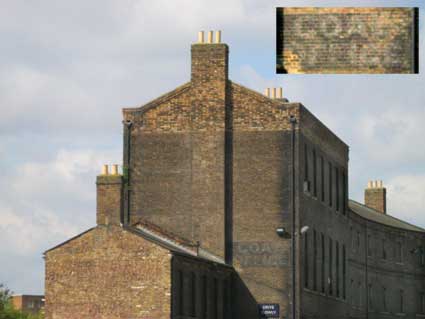 2012 image
2012 image
'COAL
OFFICE'
The canal system lying
behind King's Cross and St Pancras stations had a major role in the
industrial development of the area in the 19th century. The nearby coal
office (ghostly sign, just above the blue and white enamelled British
Railways 'Drive
slowly' sign) built on a curve and looks as if it will be saved and
refurbished.
[UPDATE
31.10.2022: the 2021 book Ghost
signs – a London story
(Roberts, S & Roy Reed; see Reading list)
has more information about this humble ghost sign. This rather grubby
(in 2012) rake of buildings stood at the heart of goods distribution
coming into London from the north of England and Scotland. Connecting
the former Great Northern Railway with the Regents Canal, this would
have been an busy admnistrative centre with different offices for
varous categories of goods. The building in 2021 houses a restaurant
which has taken the name Coal Office. Even more abstrusely, the
letterform of the sign inspired the Battlebridge font used to support
the branding of the area's redevelopment. Battlebridge
was the name of the area before it became part of the metropolis.]
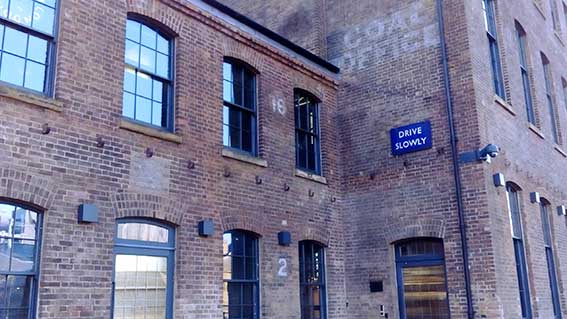
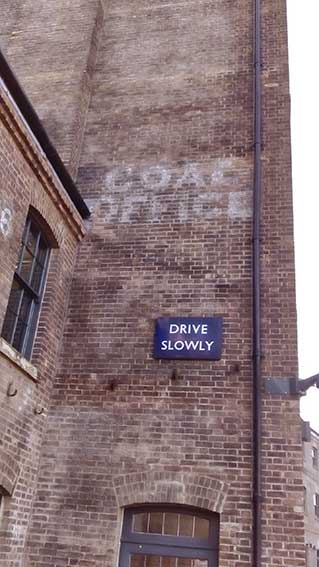 2023 images
2023 images
Above: the 2023 photographs show the buildings after renovation
to offices and accommodation. The 'Coal office' lettering and some
numerals ('16' and '2' shown here) were preserved in the cleaning and
the temptation to repaint was resisited. 'DRIVE SLOWLY'
with its white British Railways letterforms against deep blue looks
splendid.
York Road School, York Way
 2012 images
2012 images
'YORK
ROAD ... SCHOOL'
in York Way (formerly
York Road), N1. This
attractive building with its large arched entrance has been converted
into flats.
York Road station, York Way

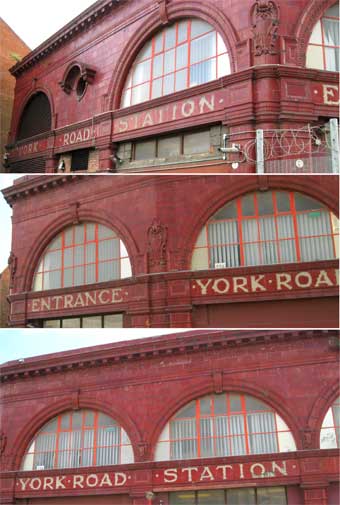
'YORK
ROAD STATION ... ENTRANCE ...
YORK ROAD STATION ...EXIT'
This corner
site was refurbished at some recent date
and the maroon livery is quite striking, albeit hemmed around with
fencing and barbed wire when these photographs were taken. The
lettering at first glance seems original, but it becomes obvious that
the shapes are where the characters once stood. Comparison with the
finish of the similar style and colour of station at Russell Square
(below) suggests that the characters have been ripped off a background,
though how this works with what appears to be ceramic tiling, we don't
know.
York Road tube station (corner of Bingfield Street and York Way) is a
disused station on the London Underground. It opened on 15 December
1906 and was one of the original stations on the Great Northern,
Piccadilly and Brompton Railway (GNP&BR), now the Piccadilly
line.
It is located between King's Cross St Pancras and Caledonian Road, and
had its entrance at the corner of York Road (now York Way) and
Bingfield Street. Unlike most other GNP&BR stations, the lifts
descended directly to platform level. Being in a poor industrial area,
the station saw little use, and Sunday services were withdrawn from 5
May 1918. The station remained open for weekday traffic until 19
September 1932 when it closed permanently. One of London's largest
redevelopment projects, King's Cross Central, began construction in
2008 across the road from the station. Islington Council and Transport
for London commissioned a study in 2005 to consider the possible
reopening of the station. In 2005 a business case was prepared to
reopen the station, to serve the Kings Cross Central development and
help relieve congestion at King's Cross St Pancras. However, this
scheme has not so far been taken up.
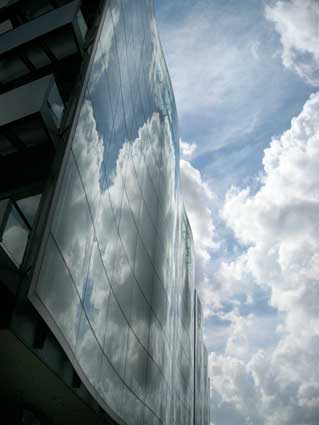
Nearby is the building in which The
Guardian
and The
Observer newspapers now
reside: King's Place, 90 York Way. The rippling fascia gave a wonderful
reflected skyscape.
Robert
Porter & Co. Ltd., Crinan Street,
King's Cross
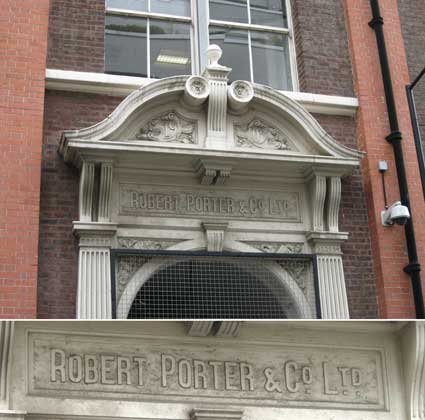
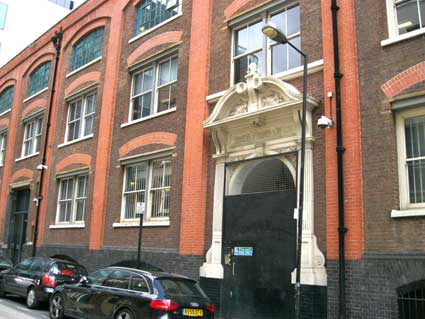
'19
... 05
ROBERT PORTER & C
O.
L
TD.'
The split date on each
side of the pediment
is very stylish with its curlicues. Beneath the company name in large
and small caps. We think this was a brewery company in Crinan Street,
King's Cross.
[UPDATE 1.5.13: 'Dear Sirs
ROBERT PORTER & CO. LTD (Beer Bottlers), 4-14 Crinan Street,
LondonN1 including Export Bottlers Ltd (Liverpool)
I worked in the accounts department for the above company from
1954- 1974. We worked five days per week plus Saturday morning until
noon. To my knowledge it was never a brewery but bottled beers
for other companies. Apart from supplying beer and soft drinks to off
-licences and working men’s clubs we also sold jeroboams of Merrydown
Cider. Deposit charged for bottles and crates. Guinness for
Arthur Guinness & Sons, Park Royal. Sold under the
“Bulldog Brand”. Young’s of Wandsworth.
Beer was bottled for Harmans Brewery at Uxbridge 500doz per run for
9/3d per dozen. Ridley’s at Chelmsford were charged 9/7d for a
run 0f 300doz. All of these were delivered by open back
lorry. Full size paper mache bulldog above the drivers
cabin. The driver always had a van boy to help him. Deliveries were
made as far away as Margate, Clacton and Southend Kursaal.
We were probably one of the first companies to bottle beer for Courage
– Horselydown. This was sold in Sainsbury supermarkets as
Sainsbury own brand. If Charrington/Whitbread or Ind Coope had
problems we would help out with bottling. We also bottled
Worthington Beer and Bass Pale Ale.
Beer was exported via barge to Holland and Denmark from the canal basin
at the back of building. Mainly India Pale Ale. Customs and
Excise
were based in a small office in Wharfdale Road bay to monitor movements
of such. When leaving in 1974 the company was bought over by Shaw
Brewery and moved to Hackney. To my knowledge it was eventually
bought by a Scottish distillery.
Hope this will fill in a few gaps as to the history of Robert Porter
and Co. Ltd. –Ada Fisher.' Our
grateful thanks to Ada for getting touch with so much detail about this
company.]
[UPDATE 9.1.2020: 'Bulldog
brand has come up in my research, too. This photo is of a relative of
mine who worked for the company. My relative is the man on the left,
but just trying to research who it could be. But the Appleby side of my
family have a long history in Kings Cross and North London for at least
over 200 years. This would be a brilliant addition for your website!
Many thanks, James Richard Appleby. Many
thanks to James for the excellent period photograph – it even has signs
on the driver's cap ['BULL DOG'], the lorry side ('BULL DOG, GUINNESS,
BASS, EXPORT BOTTLERS, Park Royal, LONDON'), faintly on the tarpaulin
('PORTER & CO.') and the buildings behind ('DAILY EXPRESS'). The
solid rubber tyres must have rattled the bottles on board, one would
have thought.]
 Image courtesy James Richard Appleby
319-321Grays Inn Road
Image courtesy James Richard Appleby
319-321Grays Inn Road
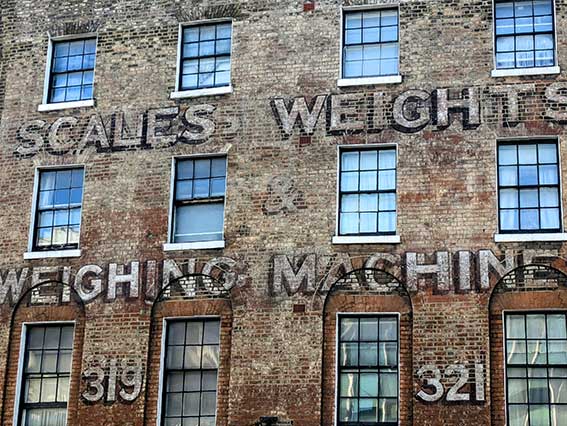 Images
courtesy David Gaylard
Images
courtesy David Gaylard
'SCALES WEIGHTS
&
WEIGHING MACHINES
319 ... 321'
in three-dimensionsl
block capitals with the ghostly (and somewhat smaller) caps of a former
sign behind. Cunning the way the letterforms flow over the recessed
arches above the first floor widows.
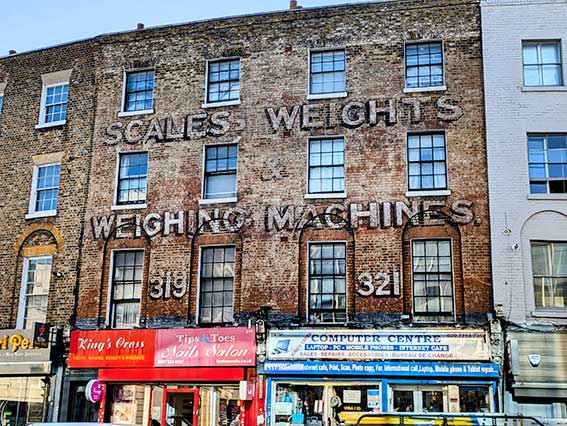 'I passed this building in perfect light on Wednesday
and noticed a ghost image behind it which I had not seen before.' This
building was apparently formerly called 37 Chichester Place. A
photograph contemporary with its heyday as a business shows the
lettering above the shop-front:
'I passed this building in perfect light on Wednesday
and noticed a ghost image behind it which I had not seen before.' This
building was apparently formerly called 37 Chichester Place. A
photograph contemporary with its heyday as a business shows the
lettering above the shop-front:
'HERBERT & SONS
ESTABLISHED 1760[?]
SCALE WEIGHT & WEIGHING MACHINE MANUFACTURERS AND
CONTRACTORS'
Interestingly, the old
photograph shows that the next-door building (painted grey here) bears
similar lettering advertising office furniture.
, York Way and
Caledonia Street
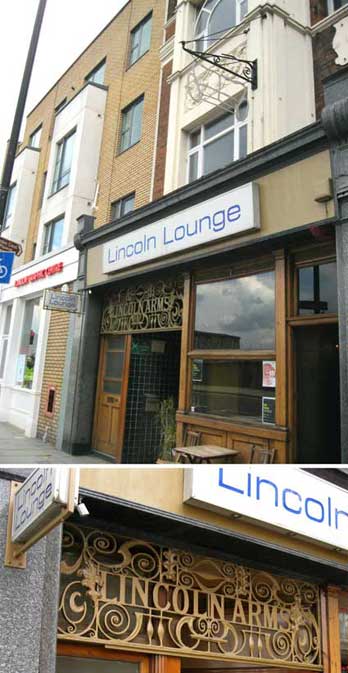
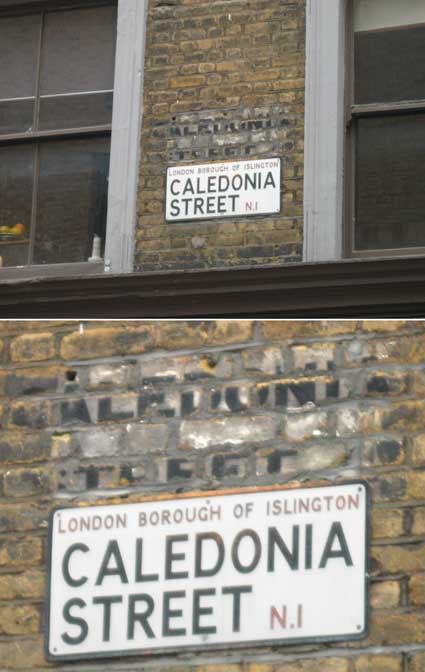
'LINCOLN
ARMS'
rather a
nice piece of pierced metalwork, still in place above the door; the
hostelry has now
inexplicably changed to the 'Lincoln Lounge', 52 York Way. Also, in a
nearby street, the metal plate of Caledonia Street sits beneath an
earlier ghostly painted street sign.
Whidborne Street
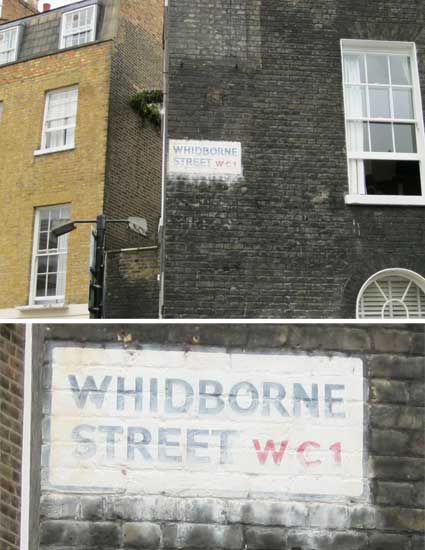
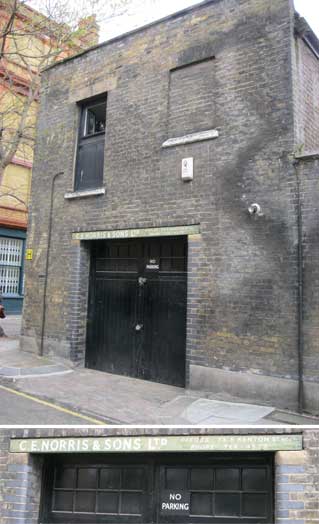
'WHIDBORNE
STREET
WC1'
(apparently whitewashed
over, now
weathering back into view) with some of the buildings therein.
'C.E.
NORRIS & SONS LTD
OFFICES - 73/5
KENTON ST. W.C.1
PHONE -
TER. 4577'
with the
obligatory, 'No Parking' sign indicating that this is probably a
private garage. The three-letter telephone
exchange code
'TER' stood for
'Terminus' (i.e. King's Cross).
Another narrow building is shown below
which bears a cast iron street sign (once covered by ivy by the traces
on it); the 'W.C.' adds a splash of colour in the grey. The Whidborne
Street sign is distinct from others shown here because of the absence
of a postal district number. This dates the nameplate to before the
First World War...
The division of London into Postal
Districts in 1857-8
effectively divided the capital into smaller and semi-independent
postal towns. Sir Rowland Hill. the designer of the first stamp and the
man who introduced the uniform postal rate for the whole country,
carved up London into eight such Districts. These were denoted by
letters representing compass points.,The original 10 districts were EC
(Eastern Central), WC (Western Central), and then NW, N, NE, E, SE, S,
SW, and W. Towards the end of the nineteenth century in London
– then
the world's largest city – the situation became clogged
again.
Initially as a war-time labour-saving device, a suffix on the Postal
District denoting the Sub-District was introduced formally in 1917. The
allocation of the numbering was alphabetical. In each district, the
sub-district nearest the centre of London was given the number 1.
Others were numbered in alphabetical order of the main delivery office
in each district. Thus the inner part of Eastern District became E1
whilst Bethnal Green Sub-District became E2 and Bow became E3. Numbers
at the end of each alphabetical sequence are later additions.
Subsequently the original Postal Districts in London became Areas and
the Sub-Districts became full Districts in modern terminology.
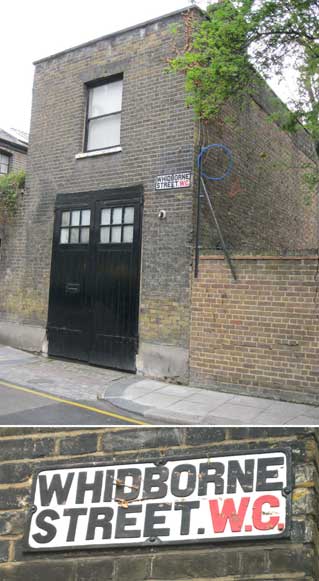
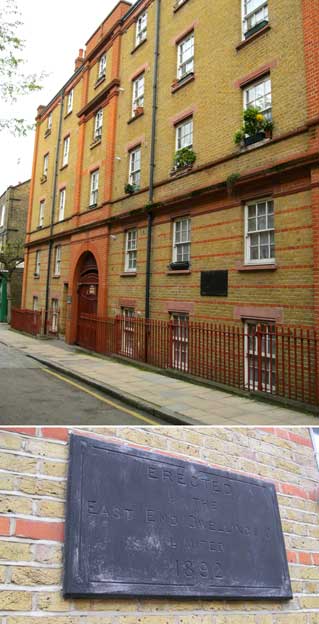
'ERECTED
BY THE
EAST END DWELLINGS CO.
LIMITED
1892'
Whidborne
House tenements. The East End Dwellings Company was a Victorian
philanthropic model dwellings company, operating in the East End of
London in the latter part of the 19th century. The company was founded
in principle in 1882 by, among others, Samuel Augustus Barnett, vicar
of St Jude's Church, Whitechapel; it was finally incorporated in 1884.
Its aim was to "house the very poor while realizing some profit",
"their particular purpose being to erect blocks of dwellings, to be let
by the room, so that the poorest class of labourers could be
accommodated".
Grenville
Mansions,
Hunter Street
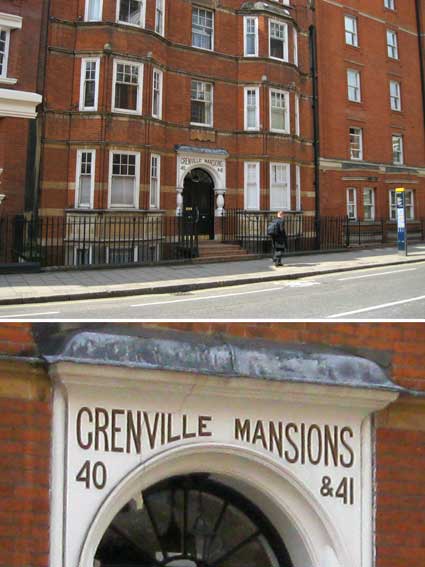
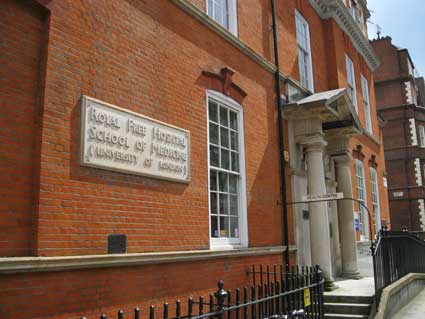
'GRENVILLE
MANSIONS ... 40 & 41'
Grenville Mansions,
Hunter Street, WC1.
'ROYAL
FREE HOSPITAL
SCHOOL OF MEDICINE
(UNIVERSITY
OF LONDON)'
London
(Royal Free Hospital) School of Medicine for Women founded on this site
(also in Hunter Street, WC1) as the London School of Medicine for Women
(LSMW) in 1874, rebuilt 1898 after becoming part of the Royal Free
Hospital. Notable graduates include future suffragettes Louisa Garrett
Anderson (her mother Elizabeth Garrett Anderson was the Dean) and Flora
Murray, who went on to found the Women's Hospital Corps during the
First World War.
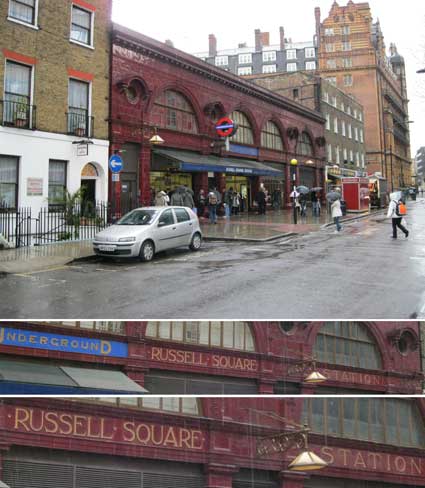
'RUSSELL
SQUARE STATION'
on Bernard
Street in a downpour. The station was opened by the Great Northern,
Piccadilly and Brompton Railway on 15 December 1906 and was designed by
Leslie Green. See the old York Road Station above.
The station was opened by the Great Northern, Piccadilly and Brompton
Railway on 15 December 1906. On 20 July 2011, English Heritage gave the
station buildings Grade II listed status, describing it as: 'a good
example of a station designed by Leslie Green to serve the GNP &
BR, later the Piccadilly Line, retaining original tiled lettering. The
interior, while altered, features of interest survive at lower levels
including tiling and directional signage. The Yerkes* group of stations
designed by Leslie Green illustrate a remarkable phase in the
development of the capital's transport system, with the pioneering use
of a strong and consistent corporate image; the characteristic ox-blood
faience façades are instantly recognisable and count among the most
iconic of London building types.'
(*To finance electrification at the beginning of the 20th century,
American financier Charles Yerkes took over the Metropolitan District
Railway and made it part of his Underground Electric Railways Company
of London (UERL) group. Electric propulsion was introduced in 1905, and
by the end of the year electric multiple units operated all of the
services. On 1 July 1933, the District Railway and the other UERL
railways were merged with the Metropolitan Railway and the capital's
tramway and bus operators to form the London Passenger Transport Board.)
St
George the Martyr Parochial School, Old Gloucester
Street

And off Queen Square, in
Old Gloucester
Street, a lettered doorway:
'ST GEORGE THE MARTYR
PAROCHIAL SCHOOLS'
and above the door to
number 25:
'BOYS'
'GLORY BE TO GOD
ST GEORGE MARTYR
SCHOOL
FOR 200 BOYS
1877
THE
FOUNDATION OF GOD
STANDETH SURE II TIM 2.19'
This is an appropriate quotation for a foundation stone with the
attribution, in the King James bible, to II Timothy 2.19; although the
last digit looks a bit like a zero.

They turned the same trick on the Girls' School over the road with a
suitable quotations from Ephesians 2.20. The carving here, although
dated earlier, is more sophisticated and in much better condition and
readability than the Boys' School stone:
'GLORY
BE TO GOD
ST. GEORGE THE MARTYR
SCHOOLS
FOR 200 GIRLS & 200 INFANTS
- 1863 -
JESUS
CHRIST HIMSELF BEING THE CHIEF CORNER STONE
EPH. II 20.'
Dairy Supply Company Ltd.,
Little Russell Street, Bloomsbury

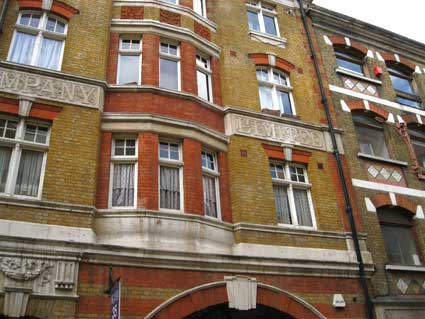
The end of the walk from King's Cross brings us to The Cartoon Museum
in Little Russell Street, Bloomsbury. The sign running over the
frontage is:
'DAIRY
SUPPLY COMPANY LIMITED'
The polychrome brick and
stonework runs round the corner into Coptic Street and reveals a wealth
of lettering.

Above the Coptic Street sign are a roundel in terra cotta and stone: 'DSCL'
and a similar rectangular feature beneath it showing a milk churn
encircled by a scroll reading: 'DAIRY
SUPPLY COMPANY'
(just readable on
our image). The lettered frieze running between the two runs right
round both
faces of the building and features a leaf and berry motif upon which
the relief serif capitals sit, stating the company name on each side:
'DAIRY
SUPPLY COMPANY LIMITED'

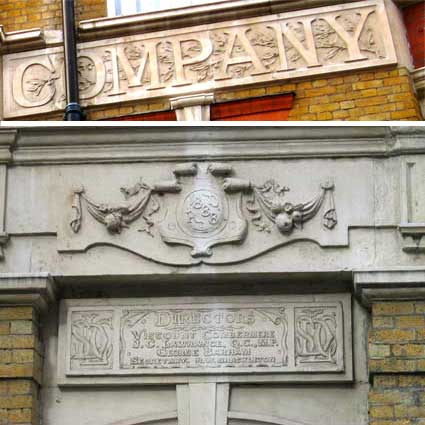
'A
1888 D
DIRECTORS
VISCOUNT
COMBERMERE
J.C.LAWRANCE, Q.C., M.P.
GEORGE BARHAM
SECRETARY. R.W. SHACKLETON'
'DSCL' [on
each side]
The crest with date and panel featuring 'Directors' are above a rather
grand entrance to the offices above. This building was designed in 1888
by R. P. Whellock. One writer has said: "Those directors turn out to be
surprisingly interesting bunch: one invented the milk churn, one was a
laughably bad High Court Judge and the third was photographed as a
ghost." This building at the corner of Coptic Street and Little Russell
Street was apparently the second restaurant to open in the Pizza
Express chain. In the dairy on Coptic Street, Whellock put in big,
round-arched windows on the ground floor; these were apparently typical
of the architecture favoured by the Dairy Supply Company. Original
diary tiles are preserved inside, too, we hear.
For further examples see our London Galleries
page.

 2023 images
2023 images
 2023 images
2023 images
 2012 images
2012 images





 Image courtesy James Richard Appleby
Image courtesy James Richard Appleby Images
courtesy David Gaylard
Images
courtesy David Gaylard















